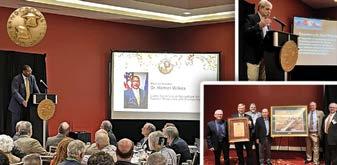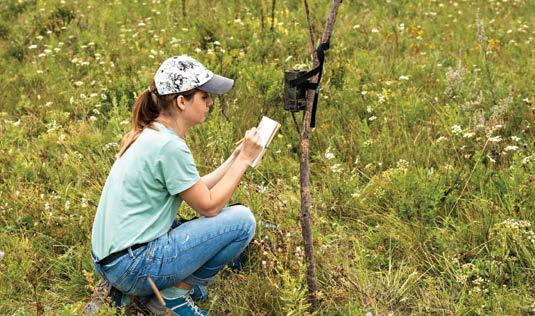
8 minute read
SCIENCE BLASTS | Identifying Tomorrow’s Wildlife Science Needs Today
IDENTIFYING TOMORROW’S WILDLIFE SCIENCE NEEDS TODAY
Science offers us a useful set of tools and approaches for asking and answering questions about the world. At the same time, philosophers, politicians, and the general public have raised and continue to raise important questions about the role of science in the broader society. For example, as we watch the decline of the latest wave of the COVID-19 pandemic in the United States, our society is engaged in an intense debate about the roles of medical and public health science, relative to other societal needs and interests. What does it mean, for example, for policy-makers to “follow the science,” and how do we apply science in public policy settings when scientific data and information change rapidly, or when studies are not yet complete, or when the results are inconclusive?
In the field of wildlife management, our North American Model of Wildlife Conservation enshrines the importance of science and scientific management of wildlife resources in its seventh pillar or principle. As stated by the Association of Fish and Wildlife Agencies on their website, “Scientific management is the proper means of wildlife conservation.” In this model, therefore, science is foundational to the entire enterprise of wildlife management and wildlife conservation. The North American Model also emphasizes the importance of public engagement and democratic rule of law. Wildlife managers are ultimately responsible to the public for the management and conservation of species that are managed “in public trust” for the benefit of society and future generations. In turn, the science that wildlife managers rely on must be responsive to these needs as well. The tenets of the North American Model thus challenge scientists to engage more effectively with managers in order to understand their needs as well as the needs of the broader public and the resource itself. But how then do scientists know which research questions to pursue, and how can scientists work most effectively with managers to provide the information and data needed for the scientific management of wildlife and their habitats? The program that I currently administer, the U.S. Geological Survey (USGS) Cooperative Fish and Wildlife Research Unit Program (Coop Unit Program), was created by Boone and Crockett Club Honorary Life Member Jay “Ding” Darling and colleagues in the 1930s to address exactly these questions. Darling and colleagues recognized the need for establishing scientific research programs where scientists could collaborate directly with state and federal wildlife managers on research projects addressing their highest priority management needs. At the same time, the scientists in the Coop Unit Program work directly with the professional staff at wildlife agencies to provide assistance on urgent technical matters. And by basing the individual programs at host universities, the Coop Unit Program scientists have the opportunity to train the next generation of conservation professionals through formal graduate programs, while at the same time offering technical assistance to wildlife managers and other natural resource professionals. Traditionally each of our 41 individual units has identified management needs and research questions at an annual coordinating meeting where all of the partners— USGS, U.S. Fish and Wildlife Service, the state fish and wildlife agency, the host university, and the Wildlife Management Institute—come together to review progress and chart the course for the year ahead. However, with the fast-paced nature of modern life, urgent questions and critical information and research needs can seemingly arise at any time. Thanks to our programs’ long-term partnership with the Wildlife Management Institute (WMI, ably led by Boone and Crockett Club Professional Member Steve Williams), the Coop Unit Program is moving into an exciting new phase of identifying and addressing the highest-priority management needs of our agency partners. Beginning in 2022, Boone and Crockett Club Professional Member Jen Mock Schaeffer will be reaching out directly to staff at state and federal wildlife management agencies to identify their highest priority needs for scientific research, training, data management, decision-making, and technical assistance in an increasingly complex and dynamic environment. Jen has worked closely with state fish and wildlife agency staff
JONATHAN R. MAWDSLEY B&C PROFESSIONAL MEMBER
Chief of the Cooperative Fish and Wildlife Research Units
for much of her career, including a 19-year stint at the Association of Fish and Wildlife Agencies where she was most recently the government affairs director. Jen brings a wealth of connections and experience to this effort. Most importantly, she has strong working relationships with the state fish and wildlife agencies, which enable her to communicate effectively with agency leadership and staff to identify their highest priority scientific and technical needs. We expect the information that Jen will provide through this project to be transformative for our program and for the research we conduct. With clear priorities identified by state agency directors and their leadership, our scientists will be able to conduct research and create tools that directly address those priorities, and truly meet the most urgent needs of wildlife managers. Most excitingly, our scientists will have the benefit of establishing longer-term research partnerships—“co-creating” programs of scientific inquiry that will continue to provide much-needed data and information to state wildlife managers on an ongoing basis. But all of this would not have been possible without Jen, Steve, and myself recognizing a critical error, a fundamental flaw in our


original study design for this project. Originally, we thought that we wanted to build an integrated data management system for the state fish and wildlife agencies, a central database and analytical tools that would combine data from multiple sources and allow managers to conduct certain analyses about population status and trends. While such a database would undoubtedly be interesting to many (and was actually discussed by the Association of Fish and Wildlife Agencies in 2014 and 2017), we realized that none of our state agency colleagues had identified this database as their highest, greatest need for scientific research or information management. Now, it is true that the subject of information and data management was identified as a priority “scientific need” on surveys conducted by the Association of Fish and Wildlife Agencies’ Science and Research Committee (ably chaired by Boone and Crockett Professional Member Dr. Russ Mason), but we recognized that we were jumping to conclusions in identifying a solution as this one “super database,” what one USFWS colleague called “the one database to rule them all.” And so we decided to start with a series of conversations with state agency directors, wildlife chiefs, and other program staff, to engage them in discussions to identify their most pressing needs—research and decision-science, analytical tools, training, technical assistance—that could be met through the Coop Unit Program. Rather than focusing our efforts on building a beautiful data management system that no-one may actually want or use, we will be able to address the needs that our state agency partners actually have. In doing so, our scientists may not necessarily build the most elegant data storage architecture, but we will be able to help meet the expressed needs of our state agency partners, thereby providing the scientific underpinnings necessary to advance conservation decisions that are vital to our broader interests of adaptable and sustainable fish and wildlife conservation and management. And this is one way how the scientific enterprise can work, at its best, to truly address the needs of managers and other groups within society. Public engagement is critical, as is effective and ongoing communications between scientists and those such as wildlife managers who hold responsibilities “in public trust” for the broader society. We are fortunate in the field of wildlife management that we have visionaries such as Jay “Ding” Darling who had the foresight to think creatively about how scientists, managers, and others could collaborate most effectively to support the conservation of wildlife, habitats, and other natural resources. We are excited about this new phase of engagement between the Coop Units and our management partners, and we look forward to sharing the outcomes and successes of this enhanced collaboration with you. n










